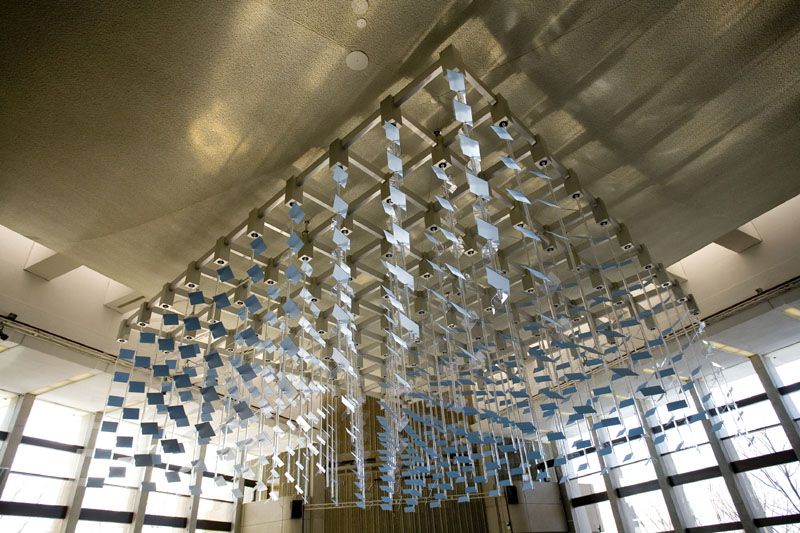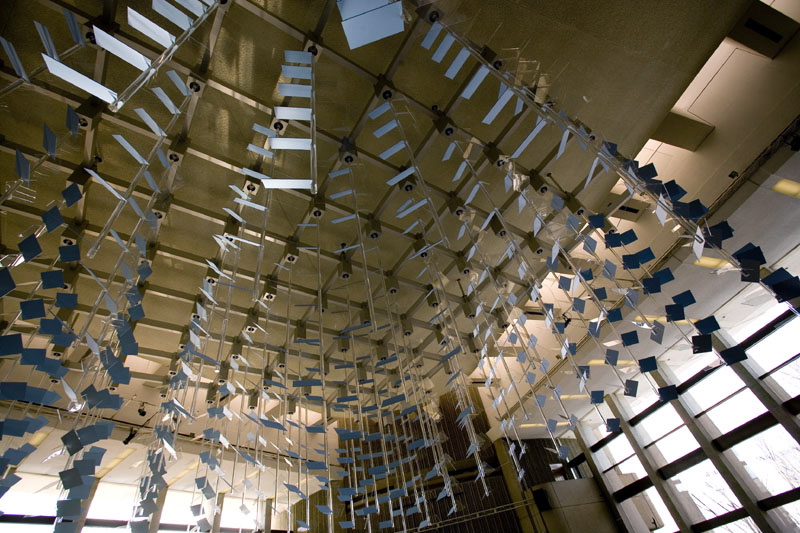Rokeby : Home
/ Works / Current
Shows / Texts / softVNS
/ Links / e-mail
me
Public Art Works : Cloud
(2007)
Commissioned by
the Ontario Science Centre, Toronto

Cloud
"Cloud" is a monumental kinetic installation hanging suspended in the Great Hall at the Ontario Science Centre. One hundred identical sculptural elements, arranged in ten by ten grid, are rotated at slightly differing speeds by computer-controlled motors. The elements slowly shift in and out of synchronization. When the motors are just out of sync, huge waves ripple across the space. When completely in sync, the work appears almost solid then suddenly almost invisible. When far out of sync, the sculptural elements float in apparent chaos.
Cloud creates constantly shifting fields and patterns in the space of the Great Hall, playing with the tension between chaos and order, between scientific theory and human experience, and between objectivity and subjectivity.
My immediate response when confronting the space of the Great Hall was that the space required and deserved something huge, yet largely transparent or diffuse... something that substantially occupied the space but animated it rather than obscured it. This made me think of the fact that all states of matter are primarily composed of empty space, sparsely populated by particles. In classical Hindu beliefs, there are five elements: earth, water, air, fire, and space. I took as a starting point this fifth element, space – both the magnificent (but challenging) space of the great hall, and the space within the structure of matter.
Loosely mapping the classical elements into contemporary terms, I arrived at SOLID, LIQUID, GAS, ENERGY, and SPACE and these are the five components of this proposed work. The solid, liquid and gaseous states of matter are largely differentiated by their manners of occupying space and reacting to and transferring energy. Solids tend to have very rigid, regular and coherent internal structures. As a solid melts into a liquid, this structural rigidity softens and breaks down but relationships between atoms within the fluid remain an important factor in their behaviour. When a liquid evaporated, the atoms shake loose of their relationships and move freely and chaotically. Energy drives these transformations which change the way the elements occupy space. In this work, Cloud, I have chosen to represent these states and transitions with a large dynamic diffuse uniform structure arrayed through the space above the visitors' heads.
In very simplistic terms, the work responds to the question: What might it be like to experience the 'space' inside a wave? inside a crystal? inside a gas?
I am also interested in the ambiguities in the definitions of those states. Research has shown that the differences between the states of matter are sometimes a matter of perspective. For example, cloud and glacial movements when played back at high speed start to resemble liquid wave patterns. In other words, whether something is a solid, liquid or gas depends partly on the frame of reference within which you choose to look at it. It is a natural characteristic of the particular spatial arrangement of Cloud that it offers a different experience and sense of the system's state from every viewing position. One visitor will see the chaotic movements of a gas as another in another position sees the ordered unfurling of a wave.
�
Installation Structure
Cloud is large arrangement of identical simple elements.
- The smallest elements of the work are a pair of thin acrylic planes 12" x 15" crossing each other perpendicularly on their short side. One is clear, the other is a light blue grey.
- Six sets of these planes are arranged in identical orientation at 2.5' intervals along a 13' acrylic shaft.
- A stepper motor slowly rotates the shaft.
- 100 of these motor shaft sets are set up in a 10 x 10 configuration at 4.5 foot intervals to create an open form about 42' x 42' x 16' high. The bottom of the bottom-most planes sets at a height of 11.5’.
- The 100 units are identical, replaceable and interchangeable. They are attached to a 10 x 10 grid of aluminum.
- All motors are connected to a computer which maintains the desired relationship of rotations speeds and positions.

Cloud from under the edge
�
Installation Behaviours
The speed of rotation of each motor is slightly different according to a strict pattern. The rotation rates are in a harmonic relationship to each other, meaning that they will from time to time all come back into complete synchronization at regular intervals. The entire cycle length will probably be around 8 - 10 minutes if allowed to unfold naturally, but this can be shortened or lengthened in various ways.
The clear and coloured planes are oriented to provide very different shape profiles at each angle of rotation and angle of viewing. The almost square rectangle collapses through a diamond shape towards invisibility, then expands again markedly changing the visual density of the structure. The clear planes with pick up subtle reflections. The coloured planes shift intensity as they rotate towards and away from the sources of light.
There are three distinct states of organization of this structure:
- When all rotations are identical, the structure resembles a solid, both subjectively and formally. (In solids, atoms tend to be in perfect alignment)
- As the rotations shift away from this solid state, the structure melts into a liquid-like flow, with waves clearly traversing the structure.
- Beyond a certain point, the relationships between the rotations becomes unclear and the structure resembles the random incoherence of a gas.
The transitions between identifiable states reflect the transitions of melting, freezing, evaporating, condensing and sublimating. There are many distinctive patterns at various points along the way. With minimal movement and minimal shape complexity, and with the play of light and perspective, a very wide array of perceptual experiences of movement and space are created.
Rokeby : Home
/ Works / Current
Shows / Texts / softVNS
/
Links / e-mail
me
Copyright 2007 David
Rokeby / very nervous systems / All rights reserved. 01/13/07


